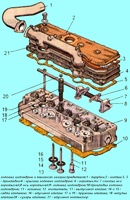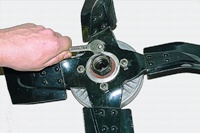The head of the block can be removed with the intake pipe and exhaust manifold
If the head of the block is removed from the engine installed on the car, you must first perform the following operations:
Remove:
- - drain liquid from the cooling system;
- - remove the air filter from the carburetor;
- - disconnect the hoses from the thermostat;
- - disconnect the wire from the coolant temperature sensor;
- - disconnect the wires from the microswitch on the carburetor;
- - disconnect the air damper rod and the accelerator drive rod from the carburetor;
- - disconnect the fuel drain hose from the carburetor;
- - disconnect the hoses from the EPHX solenoid valve installed on the bulkhead;
- - disconnect the brake booster vacuum hose from the fitting on the intake pipe;
- - disconnect the heater outlet hose from the fitting on the rear cover of the block head.
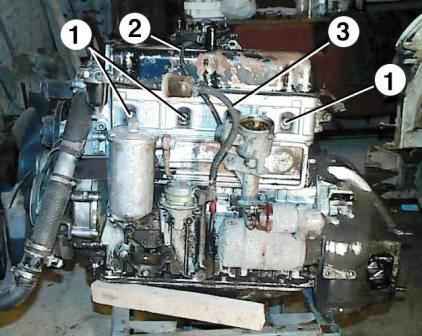
Remove the wire ends from the spark plugs and unscrew the spark plugs 1.
Disconnect hose 3 from the fuel fine filter.
Disconnect the vacuum hose 2 of the vacuum corrector of the ignition distributor from the carburetor.

Disconnect crankcase breather hose 3 from the fitting on the rocker cover.
Remove six bolts 1 and remove rocker arm cover 2 together with gasket.
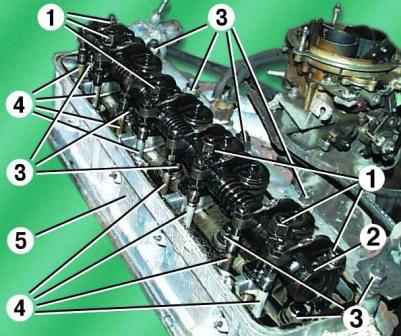
Unscrew nuts 1 and remove axle 2 with rocker arms and struts as an assembly.
Remove the 4 valve lifter rods.
Unscrew nuts 3 and remove block head 5 and head gasket.
In this case, it is not recommended to drive a screwdriver or any other tool between the block head and the cylinder block, as this may damage the surface of the block head adjacent to the block, or the surface of the cylinder block
Fix the cylinder liners by putting wide washers on the head mounting studs so that they overlap adjacent liners.
Then, put suitable pipe sections on the studs and tighten them with the block head nuts.
Disassembly:
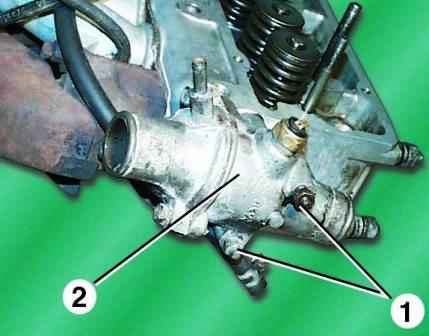
Unscrew nuts 1 and remove thermostat housing 2 with cover assembly.
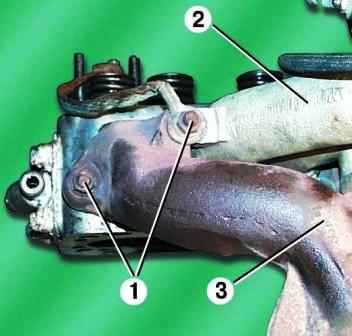
Remove six nuts 1 and remove intake pipe 2 with exhaust manifold 3 for cylinders 1 and 4.

Remove nut 1 and remove the exhaust manifold of cylinders 2, 2 and 3 from the cylinder head
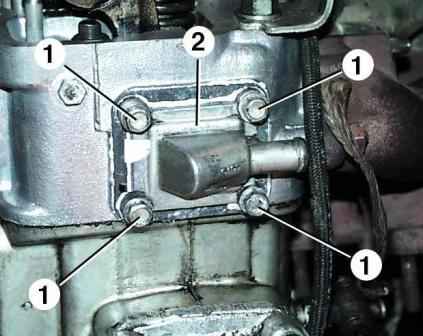
Remove bolts 1 and remove cover 2 with gasket from the rear end of the cylinder head
Mark the valves with the cylinder number so that they can be reinstalled when reassembling the cylinder head.

Install a special tool for compressing valve springs on the head of the block.
Compressing the valve springs with the tool, remove the crackers 1 valve.
Then, gradually loosening the pressure on the tool handle, fully open the valve springs.
Remove the fixture from the block head.
Remove valve springs 3 with spring plate 2.
Turn over the cylinder head and remove valve on the side of the combustion chamber.
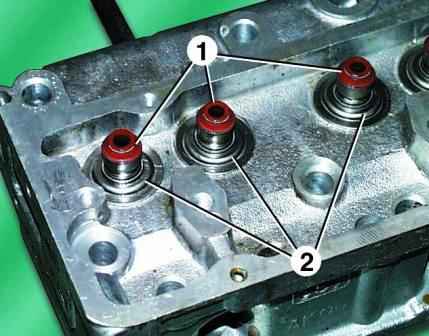
Remove the valve stem seals 1 from the valve guides and the support plates 2 of the valve springs.
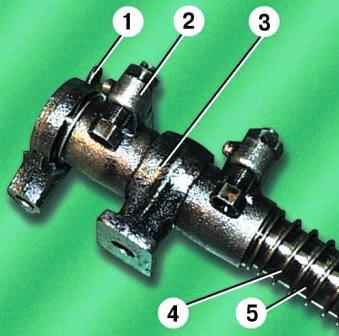
Remove the cotter pins 1 and remove the rocker arms of the rack 3 of the axle, the rocker arms 2 of the valves and the spacer spring 4 from the axle 5
Inspection, Troubleshooting and Repair
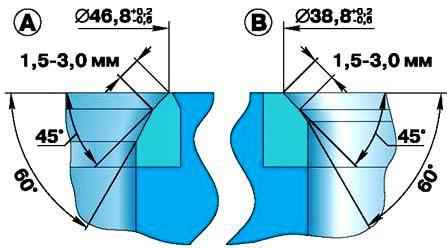
After disassembling the block head, rinse all parts in gasoline, wipe and dry. Clean the combustion chambers from soot.
Inspect the block head. If there are cracks on the jumpers between the valve seats or on the walls of the combustion chambers, traces of burnout, replace the block head.
Check with a metal ruler and feeler gauges if the flatness of the surface of the head adjacent to the block is broken.
To do this, put the ruler with an edge on the surface of the head, in the middle along, and then across and measure the gap between the plane of the head and the ruler with feelers.
If the gap exceeds 0.1 mm, replace the head.
Inspect the valves.
If cracks are found on the working chamfer of the valve, warping of the valve head, burnout, deformation of the stem, replace the valve.
Minor scratches and scratches on the valve face can be removed by lapping.
Check the condition of the valve springs. Replace bent, broken or cracked springs.
Check the condition of the valve seats. Seat edges must be free of wear, pitting, corrosion, etc.
Minor damage (minor scratches, scratches, etc.) can be removed by lapping the valves. More significant defects are eliminated by grinding.
When grinding, keep the dimensions of the saddle shown in the figure.
After grinding, check the runout of the chamfer of the seat against the hole in the valve guide, the maximum allowable runout is 0.05 mm.
After grinding the seats, grind the valves.
Then, thoroughly clean and blow out the head of the block with compressed air so that no abrasive particles remain in the channels closed by the valves and in the combustion chambers.
Check clearance between guide bushings and valves.
Clearance is calculated as the difference between the diameter of the bore in the sleeve and the diameter of the valve stem.
The maximum allowable gap is 0.25 mm.
If the gap exceeds the specified value, the valve and guide sleeve must be replaced.
The old bushing is pressed out with a mandrel from the side of the combustion chamber.
Before installation, new bushings must be cooled in carbon dioxide ("dry ice"), and the block head must be heated to 160-175 ° C.
Then insert the sleeve into the block head so that it protrudes from the side of the valve springs above the block head by 20 mm.
The sleeve should be inserted into the head freely or with little effort.
After installation, ream the hole in the sleeve to a diameter of 9.0 +0.022 mm.
Then grind the valve seat, centering the tool over the hole in the sleeve.
You can check the block head for cracks as follows.
Place a hose for compressed air supply to one of the openings of the cooling jacket.
Plug all holes in the block head with wooden plugs.
Immerse the head in a bath of water and apply compressed air at a pressure of 1.5 atm. Air bubbles will come out in places where cracks form.
Clean with wire and blow out with compressed air the holes in the axis of the rocker arms, in the rocker arms and in the adjusting screws.
Check the tightness of the bushings in the rocker arms.
If the bushing is not tight, it must be replaced, as during engine operation it can turn and block the hole for supplying oil to the pusher rod.
Assembly
The head of the block is assembled in the reverse order of disassembly.
Before installing, lubricate the valve stem seals, valve stems and valve rocker shaft with engine oil.
Install the valves in accordance with the marks made during disassembly.
Install the gasket of the thermostat housing and the gasket of the rear cover of the block head on the Hermesil type sealant.
Installation
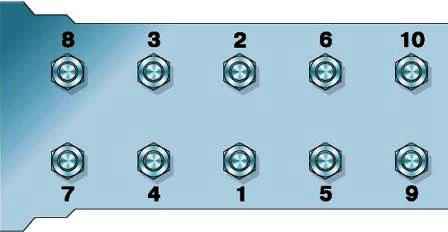
When installing the head of the block, it is recommended to replace the head gasket.
The block head is installed in the reverse order of removal.
Tightening torque 83 - 90 Nm (8.3 - 9.0 kgfm). After installing the block head, adjust the clearances in the valve drive.
Install the block head in the reverse order of removal.
Tighten the block head nuts in two steps:
- 1st stage - 40–60 Nm (4.0–6.0 kgf m);
- 2nd stage - 83-90 Nm (8.3-9.0 kgf m).








